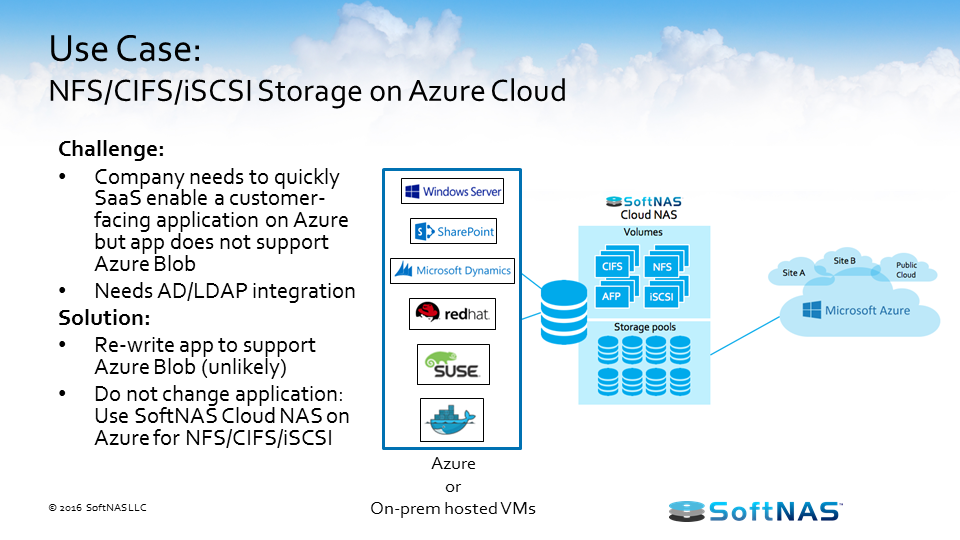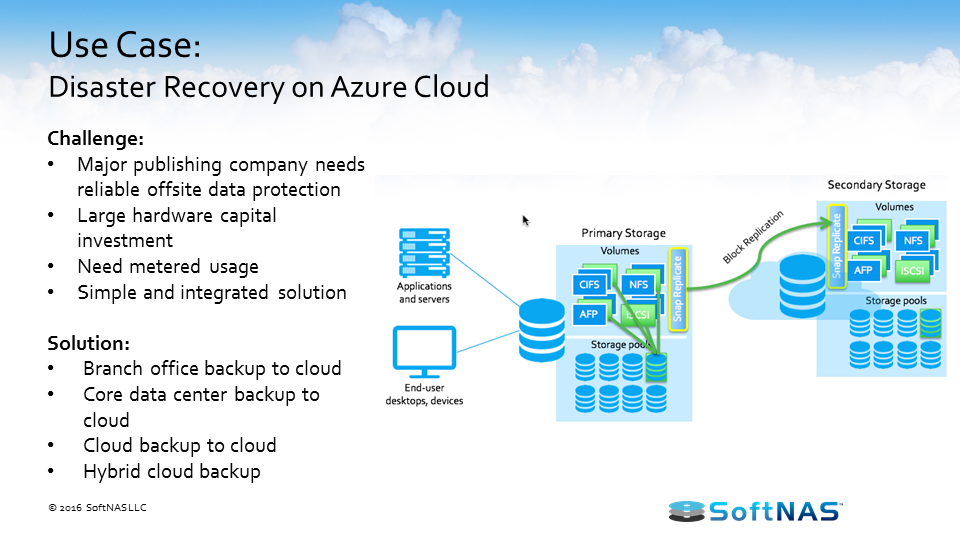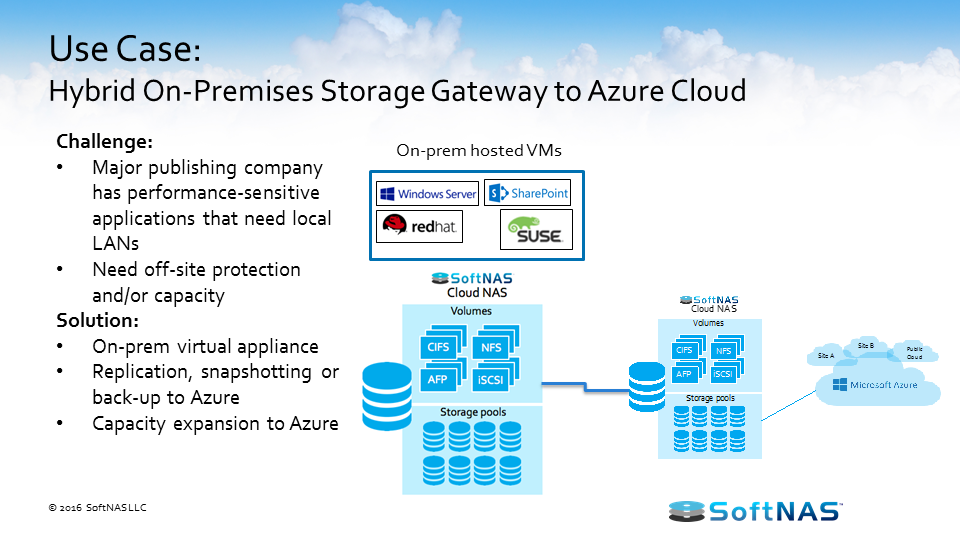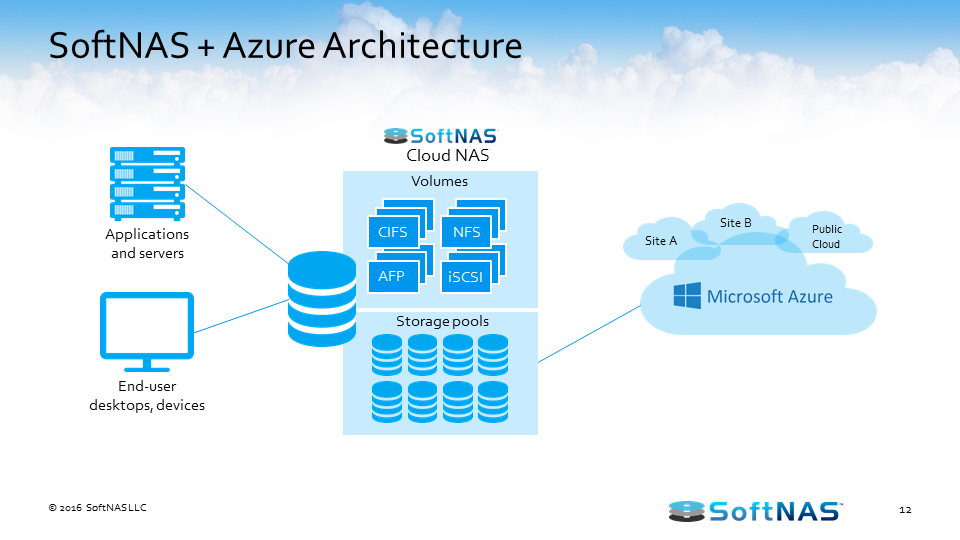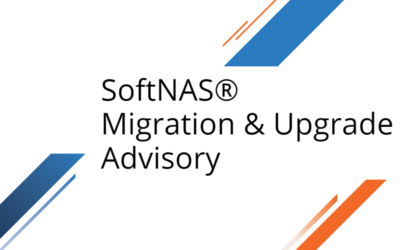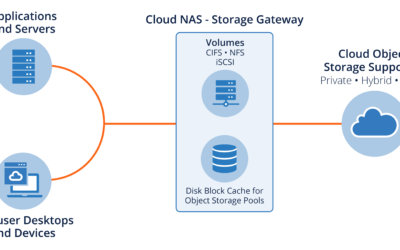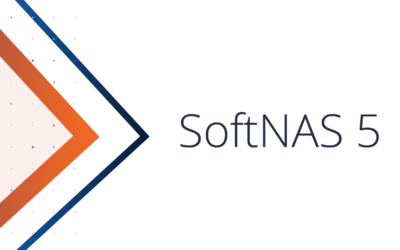On-Premises NAS to the Azure Cloud
Missed our webinar on “Moving your On-Premise NAS to the Azure Cloud?” Remember to click the button below to test drive SoftNAS Cloud NAS on Microsoft Azure today.
See the slides on SlideShare: Click here
Introduction
Today we’re going to talk about moving from a physical NAS device to the Microsoft Azure Cloud. We’ll cover some of the advantages of using Azure for your cloud storage needs. This is not a new concept. It’s on-premise versus the cloud. Microsoft Azure gives us the option to have VMs running inside of our repository and accessing our virtual NAS, SoftNAS gives you network access control towards all your storage needs within a packaged, usable space.
So how does this benefit us? We have a few use cases we want to highlight below for Azure Storage. The use cases are SaaS enables applications, disaster recovery, and hybrid storage.
Microsoft Azure NAS Storage Use Cases
For the first use case, the challenge is needing to SaaS enable a customer-facing application on Azure but the app doesn’t support Blob. They also need AD or LDAP integration for that application, so what would the solution be?
The solution would be to rewrite your application to support Blob and AD authentication. It’s unlikely that that would ever happen, right? So what else could you do? Instead of rewriting the application to support Blob, you can continue to do business the way you always have. Do you need access via NFS? We’ll just support that via NFS through SoftNAS Cloud NAS. Drop all that data on Azure back in, store it in Blob and let us do the translation. Then we could have access for all our applications on-premise or in the cloud to whatever data resources they need. It could be presented with any protocol that’s listed whether it’s CIFS, NFS, AFP, or iSCSI.
Disaster recovery on Azure Cloud Storage using SoftNAS Cloud NAS
What’s our challenge? We’ve got a company that needs reliable and offsite data protection. They’ve already created a big EMC array at their location that they have several years of support left on and they need to be able to meter its use to it. But they need to be able to have a simple integration solution. So what would be the solution? It would be easy to spin out a SoftNAS instance on premise, access that EMC array, and use the data resources for SoftNAS Cloud NAS. We can then present those air repositories to their application servers and end-users onsite and replicate all that data using SnapReplicate into Microsoft Azure. We would have our secondary Blob storage and replicate all the data that’s on-premise into the cloud.
Now what’s great about this solution is it becomes a gateway to where I’m going to get to the end of support on that EMC array. Well, we’ve got this thing running in Azure already. Why don’t we just cut the cord? We could just start directing our application resources to Azure. So that’s a great way to get you moving into the cloud and get a migration strategy moving forward.
Hybrid on Premises Storage Gateway to Azure Cloud
The last use case is hybrid on-premise usage. For example, a company has performance-sensitive applications that need a local LAN. They need off-site protection or a capacity, and the solution would be to set up replication to Azure and then have that expand capacity, so whenever they run out of space on-premise we would then be able to burst out into Azure and create more and more virtual machines to access that data, or maybe it’s a web service account that has a web portal UI or something like that needs just a web presence, and then we’re able to many copies of different web servers that are load-balanced, all accessing their same data on top of Microsoft Azure through SoftNAS NAS Storage. So all these use cases are possible. These are all use cases that I’ve had customers experience today.
SoftNAS Microsoft Azure Cloud NAS Storage
At Buurst, we’ve built our architecture to be flexible and adaptable for the cloud. We’ve built a Linux virtual machine on CentOS. It runs ZFS as our file system on that kernel. We run our systems on open controllable systems that we have staff on-site that actually contribute to these open-source amalgams to make these systems better into CentOS and ZFS and we contribute a lot of intellectual property to help advance these technologies into the future.
We run HTML5 as our admin UI and we have PHP. Apache is our web server and so we have all these open systems to allow us to be able to take advantage of a great open source community out there on the internet. And we integrate with many different service users so if you have customers that are currently running in a different public cloud and they’re looking to migrate into Azure, it’s easy for us to come in and help you make that data migration change because in starting a SoftNAS cloud service into both of those service providers and then migrating that data is simple and easy to do the task.
We can do inline deduplication, caching, storage pools, thin provisioning, writeable snapshots, and SnapClones. We can do compression, encryption, all these different offerings that we’re able to give you in a single packaged NAS solution, so once again all the things that you think you come back in like, “Okay, I’m going to have to install all that stuff and I have to buy all these different components and insert it into my hardware.” Those are all things that are assumed and used, and we’re able to just go ahead and give you our NAS Storage solution.
We’re able to present a storage capacity, so whether it be a CIFS or SMB access medium for Windows users, for some sort of Windows file share, or if it’s an NFS share for some Linux machines, or even just an iSCSI block device or an AFP (Apple File Protocol) for time machine backups, if you have end-users or end devices that need storage repositories of many different protocols, we’re able then to store that data into, say, an Azure Blob storage or even a native Azure storage device.
We’re then able to translate those protocols into an object protocol that is not a native language. We don’t speak in object whenever we’re going through a normal SMB connection, but we do also speak native object into Azure Blob. So we offer the best of both worlds with this solution, just the same as native block devices. We have a native block protocol that we’re able to talk into Azure disks that attach to these machines. We’re able to then create flexible containers that make data accessible to everyone.
Now how does this kind of play out and work in the real world? What we’re going to do is we’re going to present a single IP point of access that all these file systems will land on, so all our CIFS access, all our NFS shares, exports, all the AFP shares will all be enumerated out on a single SoftNAS instance and they will be presented to these application servers and end-users.
The storage pools are nothing more than conglomerations of disks that have been offered up by the Microsoft Azure platform, so whether it’s Microsoft Blob or it’s just native disks, if it’s even another type of object device that you’ve imported into this device, we can support all those device types and create storage pools of different technologies, and we can attach volumes and LUNs that have shares of different protocols to those storage pools so it allows us to have many different connection points to different storage technologies on the back-end, and we do this as a basic translation, and it’s all seamless to the end-user or the end device.
Q&A: Microsoft Azure Cloud NAS Storage
Question 1: What versions of NFS does SoftNAS support?
Answer: We support both version three and four for NFS. Then the follow-up that will be, the question that will be asked is, “What versions of SNB do we support?” We support two and three SNB.
Question 2: What type of RAID does SoftNAS use?
Answer: It’s ‘build your own RAID’. We don’t tell you what type of RAID you have to use. It depends on what your situation is. If you’re inside of Microsoft Azure and you trust their local disk storage is under a low enough AFR that you’re not going to have to worry about RAID in your solution or it’s not that much pressing data, then you can go ahead and use RAID 0 and get the fastest capabilities out of it. But, if you’re on-premise and you don’t have a hardware RAID solution, we give you the ability to use up to RAID 7. So if you wanted to use RAID 6 to give good performance and redundancy at the same time, you’re welcome to do that.
Question 3: How much would encryption inhibit or prevent deduplication benefits?
Answer: So that one, that’s a tricky question, right? Because deduplication actually happens on the fly, so we’re going to be doing the dedupe inline. Encryptions are not going to come into play there, so the encryption’s going to happen on the actual container itself so we’re going to actually encrypt the channel itself and then whenever we drop the data in there it’s going to dedupe.
Question 4: Does SoftNAS provide performance reports to show or see hot vs. cold data volumes?
Answer: We do provide a dashboard that gives you access to all that data. You can come in here and see which data disks are getting hit the hardest, where we have data that are just stored as, and asleep, just never touched. We do have availability access for that dashboard to see that data, and it reports in and we can actually export that via SMTP server. So you can integrate it with SMTP or SNMP via things like WhatsUp Gold or like products.
We hope that you found the content useful and that you gained something out of it. Hopefully, you don’t feel we marketed SoftNAS NAS filer too much. Our goal here was just to pass on some information about moving from your on-premise NAS to the Azure cloud. As you’re making that journey to deploying in the cloud or you’re already operational in the cloud, maybe this webinar saved you time from tripping over some of the things that other customers have tripped over.
Expand Azure Storage Efficiency with SoftNAS Cloud NAS
SoftNAS is a software-defined NAS delivered as a virtual appliance running within Azure Computing Service. It provides NAS capabilities suitable for the enterprise, including high availability utilizing Azure availability sets with automatic failover in the Azure cloud storage. SoftNAS runs within your Microsoft Azure account and offers business-critical data protection required for the non-stop operation of applications, websites, and IT infrastructure. It is designed to support a variety of market verticals, use cases, and workload types. Increasingly, SoftNAS deployed on the Azure platform to enable block and file storage services through Common Internet File System (CIFS), NFS, AFP, and iSCSI. Learn why SoftNAS for Microsoft Azure?

